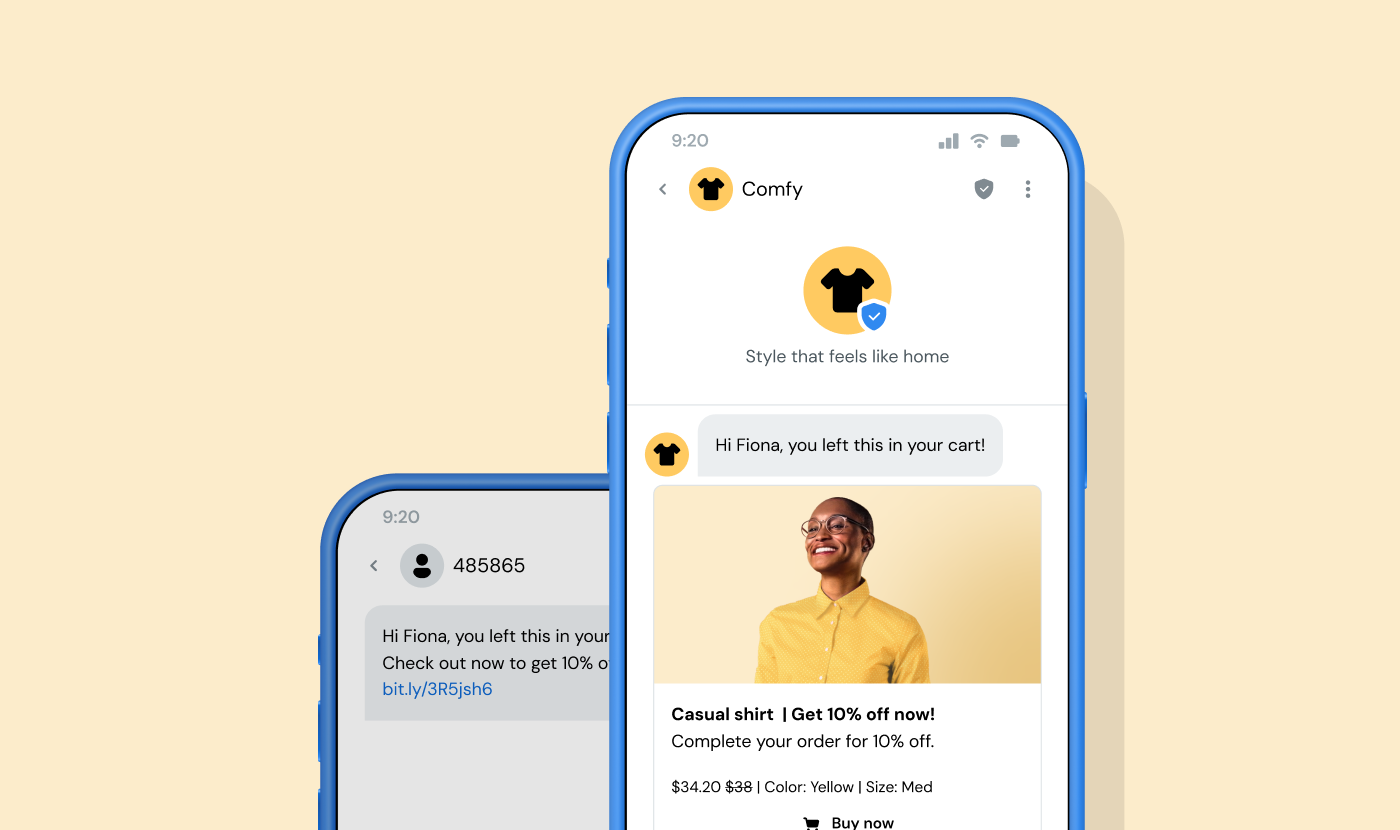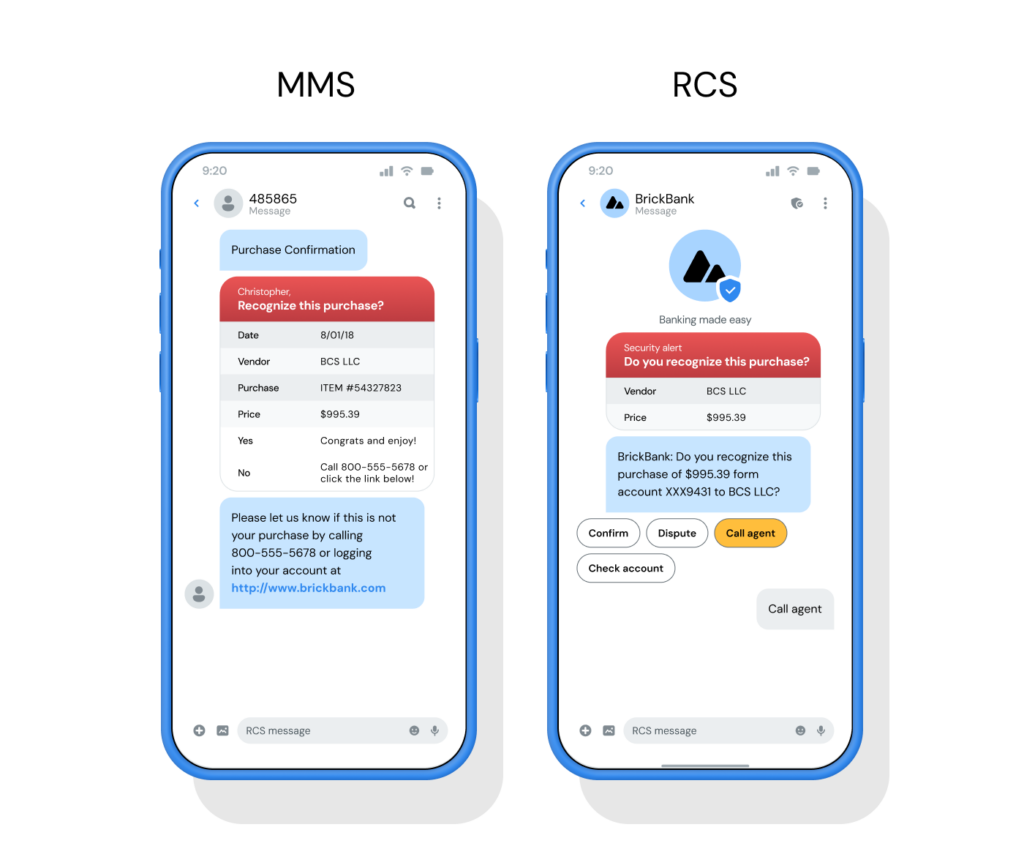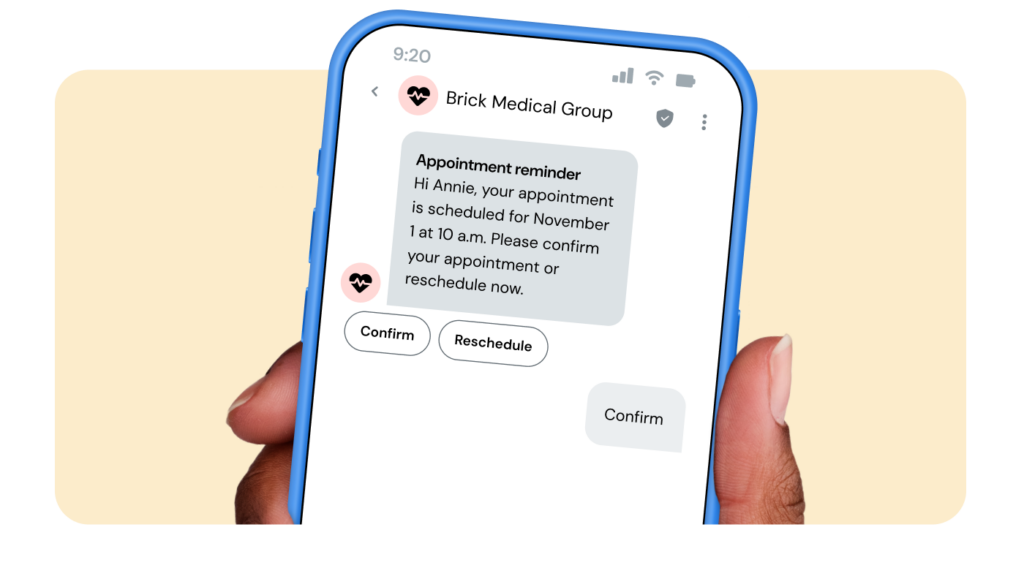Insights, Products
RCS vs MMS: A marketer’s guide for business messaging

Insights, Products

When words aren’t enough, an image or GIF can help you say a thousand more. That’s the power of using pictures and media in messaging – they can help your brand tell stories that connect and convert in a world where attention is hard to grab.
SMS has long been the tried-and-true way to send simple, text-based messages up to 160 characters. But when you want to add more impact, RCS and MMS are two powerful channels for adding images, videos, and more to mobile marketing campaigns. In this guide, we’ll break down the similarities and differences between RCS and MMS, and look at how both can help your business connect with customers and build stronger relationships.
MMS, which stands for Multimedia Messaging Service, is a richer form of SMS that allows businesses to send multimedia content like images, videos (up to 40 seconds), audio, and long text messages. This content is delivered in a way where customers can receive MMS messages even without a mobile data plan or internet connection.
MMS is an excellent choice for marketing campaigns focused on customer engagement given its high open rates. It’s great for reaching broad audiences since it works across virtually all mobile devices, meaning many brands use it when they’re looking for an easy way to add broad compatibility and a visual edge to their storytelling.

Rich Communication Services (RCS) is a messaging protocol that takes customer engagement to the next level with interactive chat features like high-resolution image and video sharing, GIFs, audio, and other rich media. Businesses that send RCS messages can also use interactive buttons, carousels, suggested replies, and maps, all which work in the native messaging app on a customer’s mobile phone.

For marketing campaigns, RCS supports business features like read receipts, typing indicators, and branded, verified sender profiles, helping marketers build trust and make data-driven decisions to improve ROI.
The business implementation of RCS, called RCS Business Messaging (RBM), is widely available on Android devices, with support currently being rolled out on Apple devices.
Both RCS and MMS offer businesses ways to engage their audiences with visual messaging that includes images, video, and multimedia. But a major difference lies in their underlying technology.
MMS is built on mobile networks, meaning it can be used in supported markets regardless of someone’s device type or carrier provided they have an MMS messaging plan. It’s reliable, widely supported, and ensures your visual messages reach a broad audience even in places where data or internet connection is limited.
RCS uses WiFi or a data network connection to offer richer, app-like messaging experiences. While RCS is available on Android devices in many markets, it’s also available in select markets with select carriers in Apple iOS 18.

MMS and RCS offer businesses the flexibility to design campaigns that match their customers’ needs – whether with the broad compatibility of MMS, or the advanced interactivity of RCS.
RCS, MMS, and over-the-top (OTT) messaging apps all serve up engaging ways for businesses to connect, but they work differently. While SMS and MMS transmit media via cellular networks, the fact that RCS uses WiFi or a cellular data connection makes it a step closer to OTT channels like WhatsApp or Facebook Messenger.
The difference? RCS doesn’t require a separate app or account – it works in someone’s phone’s built-in messaging app like Google Messages or Apple iMessage. And while OTT channels like WhatsApp require someone to download them, RCS simplifies things by being ready to go out of the box.
MMS and RCS have unique capabilities that make them suited for different business goals – or even complementary marketing strategies. Choosing the right channel depends on the type of experience you want to create and the audience you want to reach.
While MMS and RCS are different in how they operate, both share similar advantages over SMS. These include:
This table compares the differences between MMS and RCS for business messaging.
| MMS | RCS | |
| Usability | No app to download; found in the native messaging app on a user’s mobile device in select markets | No app to download; found in the native messaging app on a user’s mobile device in select markets and carriers |
| Compatibility | All mobile phones in supported markets | RCS-enabled iPhone and Android phones |
| Markets available | United States, Canada, and Australia | Coverage in markets in North America, Asia, Europe, and Latin America and continuing to expand |
| Media support | Written text, videos, pdfs, audio files, and images | High-definition images, videos, pdfs, audio, carousels, buttons, maps, and more |
| Interactivity | Slideshows, links | Suggested actions and replies, carousels, typing indicators, and app-like features |
| Connectivity | Users can receive MMS without a data plan or WiFi depending on their messaging plan | Requires WiFi or cellular data |
| Message length | Up to 5,000 characters per message (depending on your provider) | No character limit |
| Security | Messages are stored encrypted | Messages are encrypted in transit; RBM also requires business verification |
| Fallback to SMS | Yes, available | Yes, available |
Ultimately, whether you use MMS, RCS, or both, the goal is to create messaging that connects, engages, and drives results.
You might be thinking that both RCS and MMS suit your business and customer needs. And that could be true. Many businesses will use RCS and another messaging channel like MMS as part of their broader messaging strategy to cover all their bases.
Let’s dive into some specific ways RCS and MMS can enhance your business messaging.
HubSpot’s 2024 marketing report supports the idea that visual messaging is a game-changer for marketing promotions, with 91% of consumers wanting to see more online videos from brands.
And MMS and RCS are great channels to help your brand meet that desire. Because MMS has wide device compatibility, it’s a great choice for visual campaigns where reach is critical.
Lodema Steinbach, VP of Product and Carrier Relationships at Sinch, discusses the impact of MMS and picture messaging for marketers.
RCS also offers great features that can turn marketing promotions into fully interactive experiences with high-definition images, suggested actions and replies, carousels, and more. Plus, because RCS supports read receipts, marketers have insights to continually improve campaigns. These features make RCS especially well-suited for campaigns like product launches or interactive holiday campaigns.
Appointment reminders usually involve all the essential details – date, time, location – while making it easy for customers to act on them. Whether you choose MMS or RCS, both can enhance the customer experience and reduce no-shows compared to SMS messages.
With MMS, you can send visual reminders like images of a calendar, a notepad, or something more relevant to the appointment, like a haircut, medical visit, or consultation. This can make your message more memorable, so customers remember their commitments.
And with RCS, you could include high-definition visuals and interactive maps. Buttons for easy actions like rescheduling or confirming make it easy for customers to engage without leaving their messaging app.

Both MMS and RCS let you make your appointment reminders stand out – and your customers will have all the details they need!
A lot of times, abandoned carts are missed opportunities – but marketers can use MMS and RCS to turn them into conversions. Both channels offer visual and interactive tools to turn browsers into buyers.
MMS is perfect for sending a straightforward nudge; you can send a personalized reminder with an image of the product left in the cart. Add a special offer like free shopping or a discount to create urgency, and this is all you need to help reignite someone’s interest in a product.

RCS takes it a step further – you could add interactive buttons like “Buy now” or “Chat with support,” and could even include a carousel of multiple items left in the cart. You could even enhance the experience with a real-time assistance chatbot to answer questions about availability or help customers explore alternative options like nearby stock or color variations.
Whether you choose MMS for simplicity or RCS for advanced engagement, both can deliver reminders to drive action.
You can use both MMS and RCS to help your customers feel confident about their transactions and stay informed every step of the way.
You could use MMS to send payment confirmations that include key details like reference, account, or confirmation numbers after they’ve made a purchase. You could also include an image of their purchased item as a visual reminder or to help build excitement for their new order.
With RCS, you could include high-quality images of products someone has bought, personalized with their name and order details. You could even throw in a map showing their delivery route or a countdown to their expected arrival time.

Both RCS and MMS can help make sure your customers feel confident about their transactions and stay informed every step of the way.
When it comes to RCS vs MMS, we can’t give you a one-size-fits-all answer – the channel you choose boils down to what works best for your customers and marketing goals. MMS brings tried-and-true compatibility for different devices and the opportunity for visual storytelling, making it great for reaching a broad audience with impactful messages. Meanwhile, RCS takes things up a notch with interactivity and app-like features that can help you step up customer engagement.
The real win? With Sinch, you don’t have to choose just one. You can use both MMS and RCS to create campaigns that meet customers where they are while maximizing your marketing ROI. And thanks to Sinch Conversation API’s unique transcoding feature, you can set up your messages to automatically adapt to different formats. For example, you could create an RCS message to reach users, but if RCS isn’t available, Sinch automatically transcodes that message into MMS, ensuring your visuals and messaging are delivered.
This means that with just one API, you’re covered for both RCS and MMS. Transcoding messages is unique to Sinch – helping make sure you reach every customer, no matter their device.
Or, if you’re looking for a ready-to-use business messaging platform that will connect your campaigns with software like Salesforce, Shopify, and HubSpot, check out Sinch Engage.
Ready to take the next steps in your business’ messaging journey? Let’s chat! Our team is excited to help you implement a messaging strategy that your customers will love.